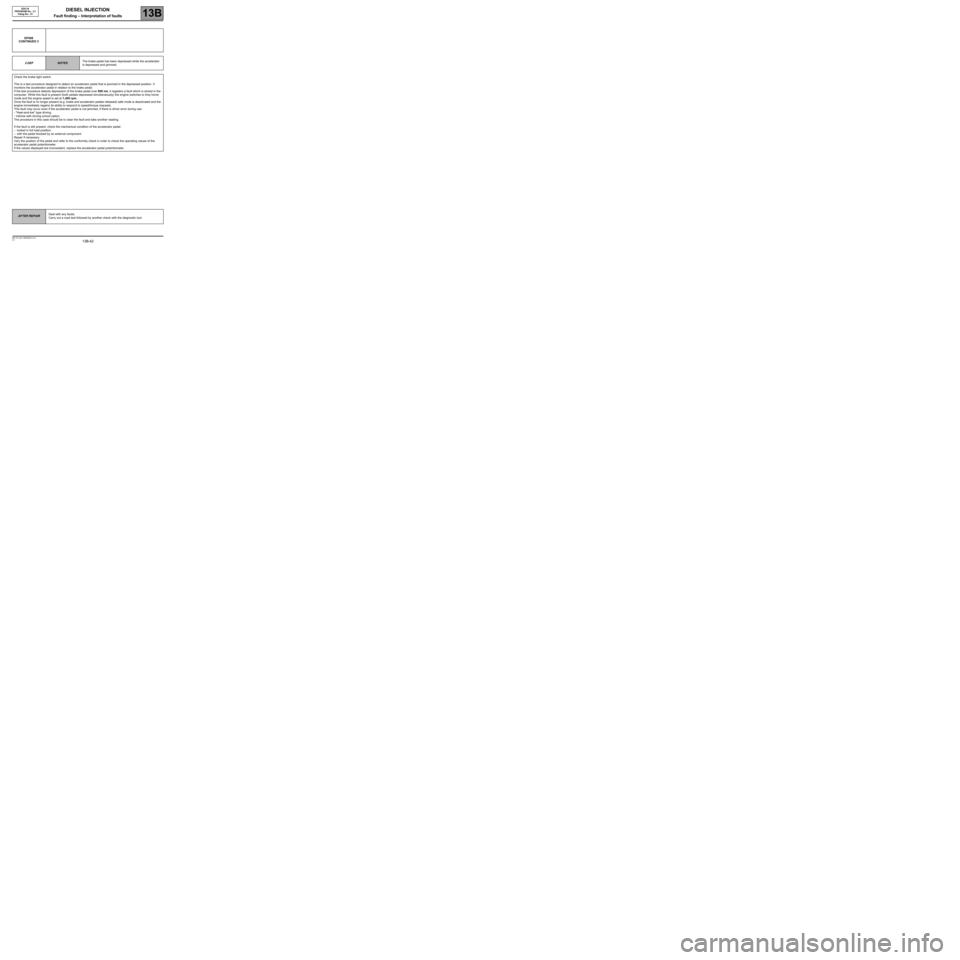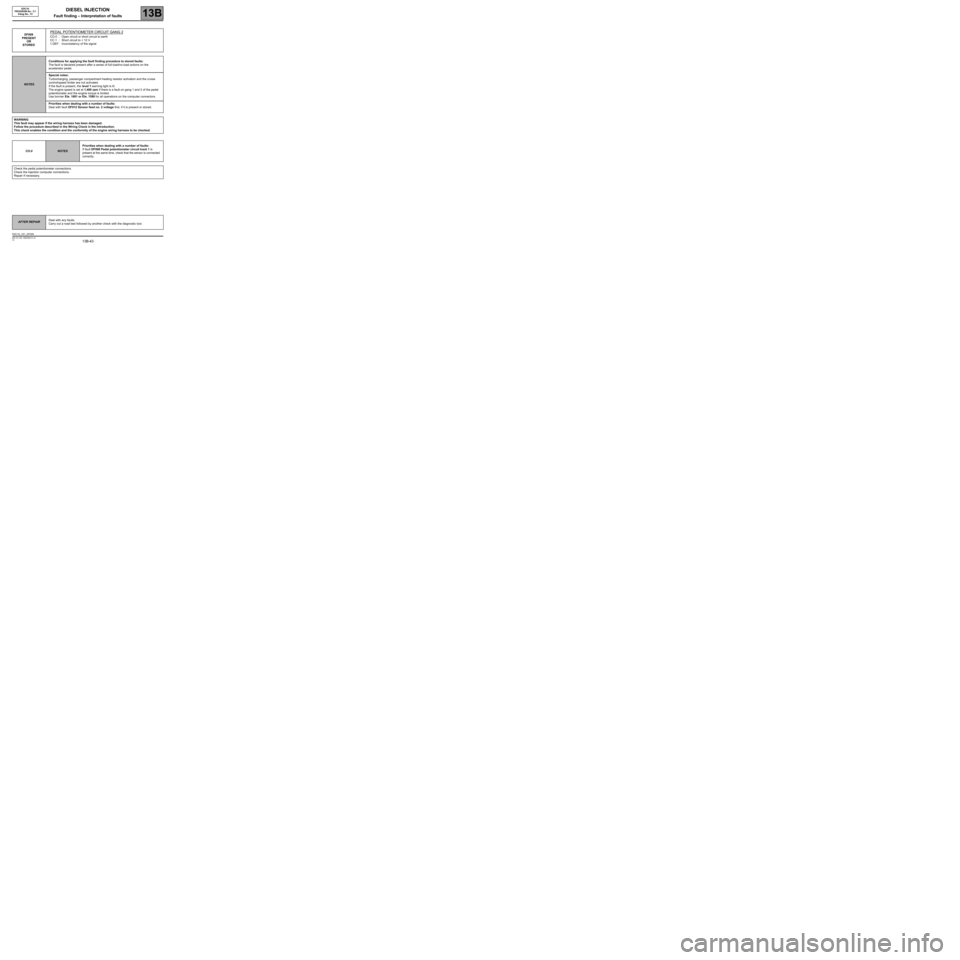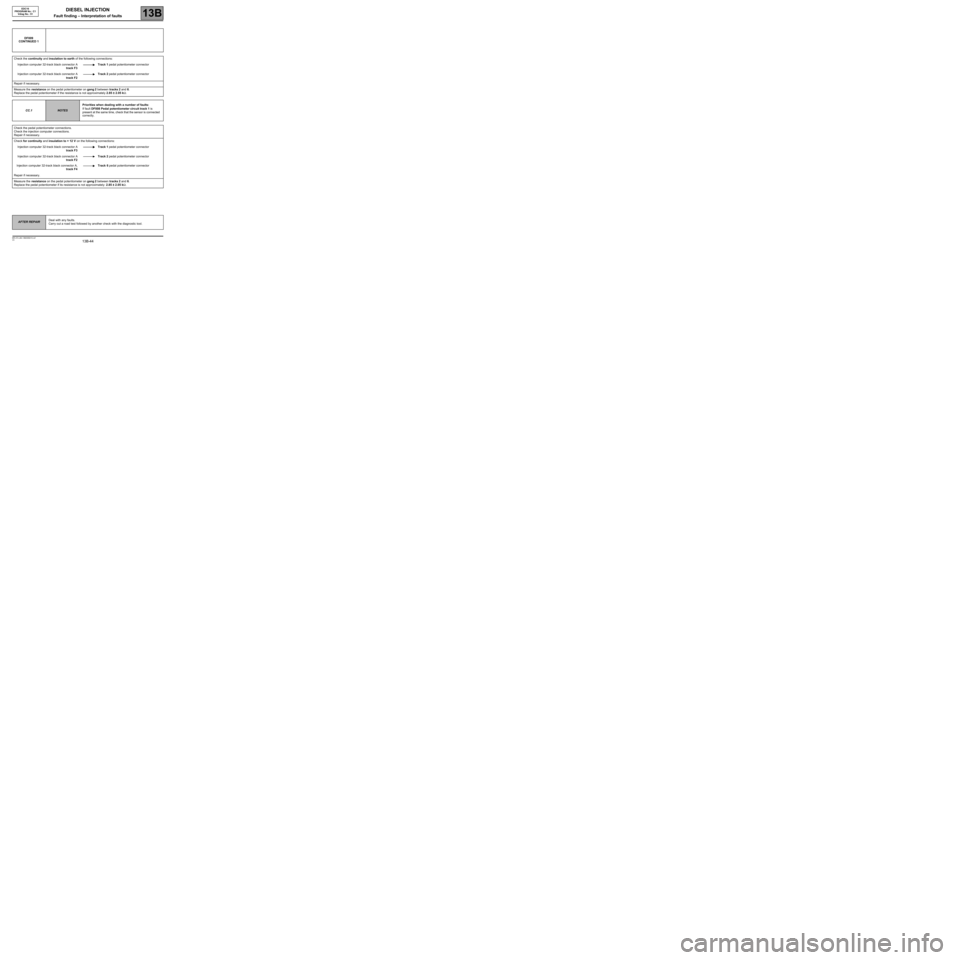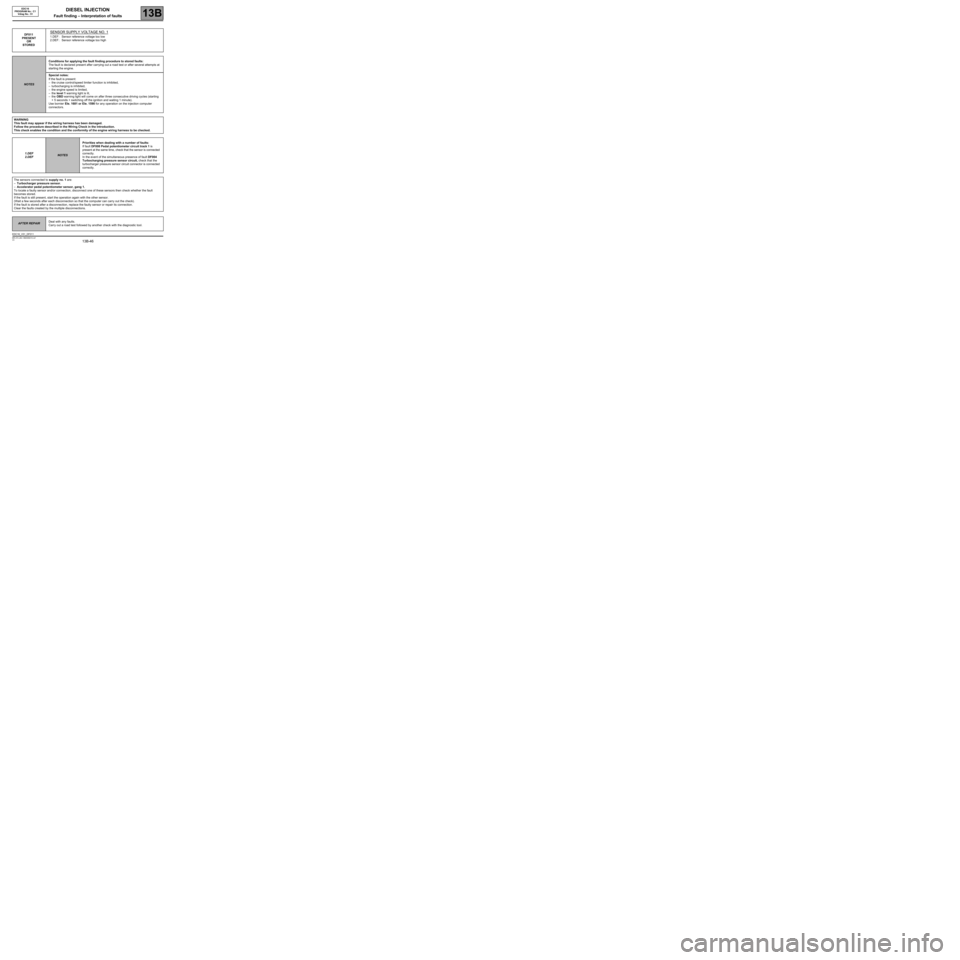RENAULT SCENIC 2009 J84 / 2.G Engine And Peripherals EDC16 Service Manual
Manufacturer: RENAULT, Model Year: 2009, Model line: SCENIC, Model: RENAULT SCENIC 2009 J84 / 2.GPages: 273
Page 41 of 273

DIESEL INJECTION
Fault finding – Interpretation of faults13B
13B-41V3 MR-372-J84-13B250$315.mif
EDC16
PROGRAM No.: C1
Vdiag No.: 51
DF008
CONTINUED 2
1.DEF
NOTESNone
Check the pedal potentiometer connections.
Check the injection computer connections.
Repair if necessary.
Check for continuity and absence of interference resistance of the following connections:
Injection computer black 32-track connector A,
track H2Track 4 pedal potentiometer sensor
Injection computer black 32-track connector A,
track G2Track 3 pedal potentiometer sensor
Injection computer black 32-track connector A,
track H3Track 5 pedal potentiometer sensor
Injection computer black 32-track connector A,
track F3Track 1 pedal potentiometer sensor
Injection computer black 32-track connector A,
track F2Track 2 pedal potentiometer sensor
Injection computer black 32-track connector A,
track F4Track 6 pedal potentiometer sensor
If the fault is still present, replace the pedal potentiometer.
2.DEF
NOTESNone
Check the mechanical condition of the accelerator pedal:
–locked in full load position,
–with the pedal blocked by an external component.
Repair if necessary.
Vary the position of the pedal and refer to the conformity check in order to check the operating values of the
accelerator pedal potentiometer.
If the values displayed are inconsistent, replace the accelerator pedal potentiometer.
AFTER REPAIRDeal with any faults.
Carry out a road test followed by another check with the diagnostic tool.
Page 42 of 273

DIESEL INJECTION
Fault finding – Interpretation of faults13B
13B-42V3 MR-372-J84-13B250$315.mif
EDC16
PROGRAM No.: C1
Vdiag No.: 51
DF008
CONTINUED 3
2.DEF
NOTESThe brake pedal has been depressed while the accelerator
is depressed and jammed.
Check the brake light switch.
This is a test procedure designed to detect an accelerator pedal that is jammed in the depressed position. It
monitors the accelerator pedal in relation to the brake pedal.
If the test procedure detects depression of the brake pedal over 600 ms, it registers a fault which is stored in the
computer. While this fault is present (both pedals depressed simultaneously) the engine switches to limp home
mode and the engine speed is set at 1,400 rpm.
Once the fault is no longer present (e.g. brake and accelerator pedals released) safe mode is deactivated and the
engine immediately regains its ability to respond to speed/torque requests.
This fault may occur even if the accelerator pedal is not jammed, if there is driver error during use:
- "Heel-and-toe" type driving,
- Vehicle with driving school option,
The procedure in this case should be to clear the fault and take another reading.
If the fault is still present, check the mechanical condition of the accelerator pedal:
–locked in full load position,
–with the pedal blocked by an external component.
Repair if necessary.
Vary the position of the pedal and refer to the conformity check in order to check the operating values of the
accelerator pedal potentiometer.
If the values displayed are inconsistent, replace the accelerator pedal potentiometer.
AFTER REPAIRDeal with any faults.
Carry out a road test followed by another check with the diagnostic tool.
Page 43 of 273

DIESEL INJECTION
Fault finding – Interpretation of faults13B
13B-43V3 MR-372-J84-13B250$315.mif
EDC16
PROGRAM No.: C1
Vdiag No.: 51
DF009
PRESENT
OR
STOREDPEDAL POTENTIOMETER CIRCUIT GANG 2
CO.0 : Open circuit or short circuit to earth
CC.1 : Short circuit to + 12 V
1.DEF : Inconsistency of the signal
NOTESConditions for applying the fault finding procedure to stored faults:
The fault is declared present after a series of full-load/no-load actions on the
accelerator pedal.
Special notes:
Turbocharging, passenger compartment heating resistor activation and the cruise
control/speed limiter are not activated.
If the fault is present, the level 1 warning light is lit.
The engine speed is set at 1,400 rpm if there is a fault on gang 1 and 2 of the pedal
potentiometer and the engine torque is limited.
Use bornier Ele. 1681 or Ele. 1590 for all operations on the computer connectors.
Priorities when dealing with a number of faults:
Deal with fault DF012 Sensor feed no. 2 voltage first, if it is present or stored.
WARNING
This fault may appear if the wiring harness has been damaged.
Follow the procedure described in the Wiring Check in the Introduction.
This check enables the condition and the conformity of the engine wiring harness to be checked.
CO.0
NOTESPriorities when dealing with a number of faults:
If fault DF008 Pedal potentiometer circuit track 1 is
present at the same time, check that the sensor is connected
correctly.
Check the pedal potentiometer connections.
Check the injection computer connections.
Repair if necessary.
AFTER REPAIRDeal with any faults.
Carry out a road test followed by another check with the diagnostic tool.
EDC16_V51_DF009
Page 44 of 273

DIESEL INJECTION
Fault finding – Interpretation of faults13B
13B-44V3 MR-372-J84-13B250$315.mif
EDC16
PROGRAM No.: C1
Vdiag No.: 51
DF009
CONTINUED 1
Check the continuity and insulation to earth of the following connections:
Injection computer 32-track black connector A
track F3Track 1 pedal potentiometer connector
Injection computer 32-track black connector A
track F2Track 2 pedal potentiometer connector
Repair if necessary.
Measure the resistance on the pedal potentiometer on gang 2 between tracks 2 and 6.
Replace the pedal potentiometer if the resistance is not approximately 2.85 ± 2.05 kΩ.
CC.1
NOTESPriorities when dealing with a number of faults:
If fault DF008 Pedal potentiometer circuit track 1 is
present at the same time, check that the sensor is connected
correctly.
Check the pedal potentiometer connections.
Check the injection computer connections.
Repair if necessary.
Check for continuity and insulation to + 12 V on the following connections:
Injection computer 32-track black connector A
track F3Track 1 pedal potentiometer connector
Injection computer 32-track black connector A
track F2Track 2 pedal potentiometer connector
Injection computer 32-track black connector A,
track F4Track 6 pedal potentiometer connector
Repair if necessary.
Measure the resistance on the pedal potentiometer on gang 2 between tracks 2 and 6.
Replace the pedal potentiometer if its resistance is not approximately: 2.85 ± 2.05 kΩ.
AFTER REPAIRDeal with any faults.
Carry out a road test followed by another check with the diagnostic tool.
Page 45 of 273

DIESEL INJECTION
Fault finding – Interpretation of faults13B
13B-45V3 MR-372-J84-13B250$315.mif
EDC16
PROGRAM No.: C1
Vdiag No.: 51
DF009
CONTINUED 2
1.DEF
NOTESNone
Check the rail pressure sensor connectors.
Check the injection computer connections.
Repair if necessary.
Check for continuity and absence of interference resistance of the following connections:
Injection computer black 32-track connector A,
track F3Track 1 pedal potentiometer sensor
Injection computer black 32-track connector A,
track F2Track 2 pedal potentiometer sensor
Injection computer black 32-track connector A,
track F4Track 6 pedal potentiometer sensor
Injection computer black 32-track connector A,
track H2Track 4 pedal potentiometer sensor
Injection computer black 32-track connector A,
track G2Track 3 pedal potentiometer sensor
Injection computer black 32-track connector A,
track H3Track 5 pedal potentiometer sensor
Repair if necessary.
If the fault is still present, replace the pedal potentiometer.
AFTER REPAIRDeal with any faults.
Carry out a road test followed by another check with the diagnostic tool.
Page 46 of 273

DIESEL INJECTION
Fault finding – Interpretation of faults13B
13B-46V3 MR-372-J84-13B250$315.mif
EDC16
PROGRAM No.: C1
Vdiag No.: 51
DF011
PRESENT
OR
STOREDSENSOR SUPPLY VOLTAGE NO. 1
1.DEF : Sensor reference voltage too low
2.DEF : Sensor reference voltage too high
NOTESConditions for applying the fault finding procedure to stored faults:
The fault is declared present after carrying out a road test or after several attempts at
starting the engine.
Special notes:
If the fault is present:
–the cruise control/speed limiter function is inhibited,
–turbocharging is inhibited,
–the engine speed is limited,
–the level 1 warning light is lit,
–the OBD warning light will come on after three consecutive driving cycles (starting
+ 5 seconds + switching off the ignition and waiting 1 minute).
Use bornier Ele. 1681 or Ele. 1590 for any operation on the injection computer
connectors.
WARNING
This fault may appear if the wiring harness has been damaged.
Follow the procedure described in the Wiring Check in the Introduction.
This check enables the condition and the conformity of the engine wiring harness to be checked.
1.DEF
2.DEF
NOTESPriorities when dealing with a number of faults:
If fault DF008 Pedal potentiometer circuit track 1 is
present at the same time, check that the sensor is connected
correctly.
In the event of the simultaneous presence of fault DF004
Turbocharging pressure sensor circuit, check that the
turbocharger pressure sensor circuit connector is connected
correctly.
The sensors connected to supply no. 1 are:
–Turbocharger pressure sensor.
–Accelerator pedal potentiometer sensor, gang 1.
To locate a faulty sensor and/or connection, disconnect one of these sensors then check whether the fault
becomes stored.
If the fault is still present, start the operation again with the other sensor.
(Wait a few seconds after each disconnection so that the computer can carry out the check).
If the fault is stored after a disconnection, replace the faulty sensor or repair its connection.
Clear the faults created by the multiple disconnections.
AFTER REPAIRDeal with any faults.
Carry out a road test followed by another check with the diagnostic tool.
EDC16_V51_DF011
Page 47 of 273

DIESEL INJECTION
Fault finding – Interpretation of faults13B
13B-47V3 MR-372-J84-13B250$315.mif
EDC16
PROGRAM No.: C1
Vdiag No.: 51
DF011
CONTINUED
If the fault is still present when both these sensors have been disconnected:
1. Check the earth insulation of the following connections:
Injection computer brown 48-track connector B,
track G4Track 3 of the turbocharger pressure sensor
Injection computer brown 48-track connector B,
track K2Track 4 of the turbocharger pressure sensor
Injection computer black 32-track connector A,
track G2Track 3 of the accelerator pedal potentiometer
gang 1
Injection computer black 32-track connector A,
track H2Track 4 of the accelerator pedal potentiometer
gang 1
Repair if necessary.
2. Check the insulation from + 12 V of the following connections:
Injection computer brown 48-track connector B,
track K2Track 4 of the turbocharger pressure sensor
Injection computer brown 48-track connector B,
track D4Track 1 of the turbocharger pressure sensor
Injection computer brown 48-track connector B,
track G4Track 3 of the turbocharger pressure sensor
Injection computer black 32-track connector A,
track H3Track 5 of the accelerator pedal potentiometer
gang 1
Injection computer black 32-track connector B,
track H2Track 4 of the accelerator pedal potentiometer
gang 1
Injection computer black 32-track connector B,
track G2Track 3 of the accelerator pedal potentiometer
gang 1
Repair if necessary.
3. Check the insulation between the following connections after disconnecting the sensors and the
injection computer:
–tracks 1 and 3 of the turbocharging pressure sensor connector,
–tracks 3 and 5 of the pedal track 1 sensor connector.
If these checks do not produce the correct results, replace the faulty sensor(s).
If the fault is still present, contact the Techline.
AFTER REPAIRDeal with any faults.
Carry out a road test followed by another check with the diagnostic tool.
Page 48 of 273

DIESEL INJECTION
Fault finding – Interpretation of faults13B
13B-48V3 MR-372-J84-13B250$315.mif
EDC16
PROGRAM No.: C1
Vdiag No.: 51
DF012
PRESENT
OR
STOREDSENSOR SUPPLY VOLTAGE No. 2
1.DEF : Sensor reference voltage too low
2.DEF : Sensor reference voltage too high
NOTESConditions for applying the fault finding procedure to stored faults:
The fault is declared present following a road test or after attempting to start the engine
several times.
Special notes:
If the fault is present:
–the EGR functions and passenger compartment heating resistance functions are
inhibited,
–the cruise control/speed limiter function is inhibited,
–the engine speed is limited,
–the level 1 warning light is lit,
–the OBD warning light will come on after three consecutive driving cycles (starting
+ 5 seconds + switching off the ignition and waiting 1 minute).
Use bornier Ele. 1681 or Ele. 1590 for any operation on the injection computer
connectors.
WARNING
This fault may appear if the wiring harness has been damaged.
Follow the procedure described in the Wiring Check in the Introduction.
This check enables the condition and the conformity of the engine wiring harness to be checked.
The sensors connected to feed no. 2 are:
–EGR valve position sensor.
–Accelerator pedal potentiometer sensor gang 2.
–Refrigerant pressure sensor.
To locate a faulty sensor and/or connection, disconnect one of these sensors then check whether the fault
becomes stored.
If the fault is still present, repeat the operation with the other sensors.
(Wait a few seconds after each disconnection so that the computer can carry out the check).
If the fault is stored after a disconnection, replace the faulty sensor or repair its connection.
Clear the faults created by the multiple disconnections.
Check the condition of the connector of the EGR valve position sensor, component code 1460, of the accelerator
pedal potentiometer sensor gang 2, component code 921 and of the refrigerant pressure sensor, component code
1202.
Check the condition of the injection computer connector, component code 120.
If the connectors are faulty and if there is a repair procedure (see Technical Note 6015A, Repairing electrical
wiring, Wiring: Precautions for repair), repair the connector, otherwise replace the wiring.
AFTER REPAIRDeal with any faults.
Carry out a road test followed by another check with the diagnostic tool.
EDC16_V51_DF012
Page 49 of 273

DIESEL INJECTION
Fault finding – Interpretation of faults13B
13B-49V3 MR-372-J84-13B250$315.mif
EDC16
PROGRAM No.: C1
Vdiag No.: 51
DF012
CONTINUED 1
If the fault is still present when the three sensors have been disconnected:
1. Check the earth insulation of the following connections:
Injection computer brown 48-track connector B,
track F4Track 2 of the EGR valve connector
Injection computer brown 48-track connector B,
track J2Track 6 of the EGR valve connector
Injection computer black 32-track connector A,
track F2Track 2 of the accelerator pedal potentiometer
gang 2
Injection computer black 32-track connector A,
track F3Track 1 of the accelerator pedal potentiometer
gang 2
Injection computer brown 48-track connector B,
track F3Track B of the refrigerant pressure sensor
Injection computer brown 48-track connector B,
track F1Track C of the refrigerant pressure sensor
Repair if necessary.
AFTER REPAIRDeal with any faults.
Carry out a road test followed by another check with the diagnostic tool.
Page 50 of 273

DIESEL INJECTION
Fault finding – Interpretation of faults13B
13B-50V3 MR-372-J84-13B250$315.mif
EDC16
PROGRAM No.: C1
Vdiag No.: 51
DF012
CONTINUED 2
2. Check the insulation from + 12 V of the following connections:
Injection computer brown connector B track F4 Track 2 of the EGR valve connector
Injection computer brown connector B track J2 Track 6 of the EGR valve connector
Injection computer grey connector C track C2 Track 4 of the EGR valve connector
Injection computer black connector A, track F2 Track 2 of the accelerator pedal potentiometer
gang 2
Injection computer black connector A, track F3 Track 1 of the accelerator pedal potentiometer
gang 2
Injection computer black connector A, track F4 Track 6 of the accelerator pedal potentiometer
gang 2
Injection computer brown 48-track connector B,
track F3Track B of the refrigerant pressure sensor
Injection computer brown 48-track connector B,
track F1Track C of the refrigerant pressure sensor
Injection computer grey 32-track connector C,
track C3Track A of the refrigerant pressure sensor
Repair if necessary.
3. Check the insulation between the following connections after disconnecting the sensors and the
injection computer:
–tracks 2 and 6 of the pedal track 2 sensor connector.
–tracks 2 and 4 of the EGR valve position sensor connector.
–tracks B and A of the refrigerant pressure sensor connector.
If these checks do not produce the correct results, replace the faulty sensor(s).
If the fault is still present, contact the Techline.
AFTER REPAIRDeal with any faults.
Carry out a road test followed by another check with the diagnostic tool.